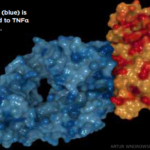In 59,970 twins aged 35 years or older, Magnusson et al. compared how much genetics contributes to osteoarthritis (OA) with the genetic contribution to other rheumatic/musculoskeletal diseases (RMDs) in the same population, while exploring the role of shared genetics in OA and other RMDs. The researchers used data from the Swedish Twin Registry, in addition to the Swedish National Patient Register. They concluded that the heritability (i.e., the total genetic contribution to a trait) of OA is relatively large compared with other rheumatic musculoskeletal diseases.

Insight into the FDA Approval of Ustekinumab Biosimilar
In late October, the FDA approved the first biosimilar to ustekinumab to treat patients with psoriasis, psoriatic arthritis and other conditions. Ustekinumab-auub is expected to be available in the U.S. by 2025.

Skin & Joints: Experts Discuss Advances in PsA
SAN DIEGO—The understanding of the microenvironment in which immune cells interact with stromal cells in the synovium of psoriatic arthritis (PsA) and rheumatoid arthritis (RA) is deepening, potentially giving clues for treatments. As this understanding improves, so does the appreciation for its astounding complexity, an expert said here in a session at ACR Convergence, which…

The Heterogeneity of Psoriatic Arthritis
SAN DIEGO—Differences between psoriatic arthritis and rheumatoid arthritis highlight the need for the development of imaging modalities, laboratory tests and other biomarkers that are explored and validated specifically for PsA to advance the goal of personalized or precision medicine. In this article, expert David S. Pisetsky, MD, PhD, explores the top research in psoriatic arthritis presented at ACR Convergence 2023.

More Than Meets the Eye
SAN DIEGO—In recent years, the recognition of nr-axSpa has helped identify the cause of back pain in many patients previously without a diagnosis. However, questions remain about how to avoid under- or over-diagnosing the condition. In the session titled, Pearls and Pitfalls in Diagnosing Non-Radiographic Axial Spondyloarthritis, several speakers provided high-yield insights on this topic. Diagnostic challenges, imaging options and mimics to watch for were among the specific points of discussion.

From Basic Science to Clinical Treatments: An Update on PsA
Dr. Christopher Ritchlin provided insights into the underlying mechanisms of the immune system that promote disease activity in patients with psoriatic arthritis (PsA), the latest research on how to optimize therapy for PsA and more.

Why Mental Health Screening Is Essential for Patients with Psoriatic Disease
Research suggests that patients with psoriasis and psoriatic arthritis (PsA) have a greater risk of depression, anxiety and, in some cases, substance abuse and dependence than the general population, yet symptoms often go unrecognized and untreated by medical professionals. Both psoriasis and PsA are associated with depression, with up to 30% of patients in either…
FDA Grants Interchangeable Designation to Pfizer’s Abrilada, Biosimilar to AbbVie’s Humira
On Oct. 5, Pfizer announced that Abrilada (adalimumab-afzb), its biosimilar to Humira (adalimumab), had received an interchangeable designation from the U.S. Food & Drug Administration (FDA).

Psoriatic Arthritis Drugs at a Glance, 2023
Biosimilars have become a therapeutic turning point for many patients who are living with rheumatic illnesses. Psoriatic arthritis (PsA) is a complex, multi-faceted chronic inflammatory musculoskeletal and skin disease where the treatment has changed considerably over the past few years. Psoriatic arthritis has an impact on about 30% of people with psoriasis.1 In 2019, the…

First Biosimilar to Adalimumab (Humira) Enters the U.S. Market After Years of Legal Battles
After years of legal disputes between drug makers, adalimumab-atto (Amjevita) biosimilar to adalimumab (Humira) is now available in the U.S. to treat rheumatoid arthritis and other diseases. Adalimumab-atto is the first of several biosimilars to adalimumab expected to become available in the U.S. in 2023.
- « Previous Page
- 1
- 2
- 3
- 4
- 5
- …
- 16
- Next Page »